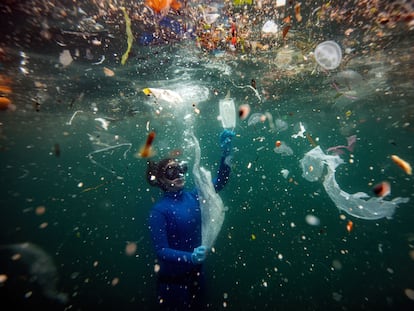Bisphenol A: Health experts drastically reduce safe intake limits of widespread plastic
The European Commission has announced plans to ban this compound, which is present in a wide variety of food packaging and is now considered a health risk

A tin of tuna (100 grams) can contain, on average, 3.7 micrograms of bisphenol A
The European Food Safety Authority (EFSA) has this year revised the limits of bisphenol A (BPA) that are considered safe in our body. The threshold is now 20,000 times lower
75 tins
7.5 kilograms of tuna
With the previous limits, it was considered safe for a person weighing 70 kg (154 pounds) to ingest the amounts of bisphenol contained in around 75 cans of tuna packaged with this plastic on a daily basis
According to a review of the data published this year, the safe amount of BPA is exceeded by 264 times by consuming a single can

A tin of tuna (100 grams) can contain, on average, 3.7 micrograms of bisphenol A
The European Food Safety Authority (EFSA) has this year revised the limits of bisphenol A (BPA) that are considered safe in our body. The threshold is now 20,000 times lower
75 tins
7.5 kilograms of tuna
With the previous limits, it was considered safe for a person weighing 70 kg (154 pounds) to ingest the amounts of bisphenol contained in around 75 cans of tuna packaged with this plastic on a daily basis
According to a review of the data published this year, the safe amount of BPA is exceeded by 264 times by consuming a single can

A tin of tuna (100 grams) can contain, on average, 3.7 micrograms of bisphenol A
The European Food Safety Authority (EFSA) has this year revised the limits of bisphenol A (BPA) that are considered safe in our body. The threshold is now 20,000 times lower
75 tins
7.5 kilograms of tuna
With the previous limits, it was considered safe for a person weighing 70 kg (154 pounds) to ingest the amounts of bisphenol contained in around 75 cans of tuna packaged with this plastic on a daily basis
According to a review of the data published this year, the safe amount of BPA is exceeded by 264 times by consuming a single can

A tin of tuna (100 grams) can contain, on average, 3.7 micrograms of bisphenol A
The European Food Safety Authority (EFSA) has this year revised the limits of bisphenol A (BPA) that are considered safe in our body. The threshold is now 20,000 times lower
75 tins
7.5 kilograms of tuna
With the previous limits, it was considered safe for a person weighing 70 kg (154 pounds) to ingest the amounts of bisphenol contained in around 75 cans of tuna packaged with this plastic on a daily basis
According to a review of the data published this year, the safe amount of BPA is exceeded by 264 times by consuming a single can
Every time someone eats or drinks a packaged product, it is very likely that they are ingesting microscopic amounts of bisphenol A (BPA), a plastic widely used by the food industry that has been in the sights of the health authorities for several years. It is what is known as an endocrine disruptor, a substance that can alter the proper functioning of the body. Until this year, the European Food Safety Authority (EFSA) maintained that these traces were within the limits of what was considered safe. But a revision published in April has turned that assertion upside down: the new guidelines establish thresholds 20,000 times lower than previously and now practically any intake of BPA, however small, is considered “a health risk.”
In the face of the report, the European Commission is planning to ban BPA in all food packaging, but before that can be done safe alternatives will have to be found. The commission has taken action in the past, reducing the permitted amounts as studies increasingly questioned the safety of BPA. In 2011, it was banned from baby bottles and food and beverages intended for children under three years of age, as children and pregnant women are the most sensitive to BPA. But the new EFSA report is expected to lead to a blanket ban on the substance.
In the meantime, many questions arise: How does BPA affect health? What foods are most contaminated? What alternatives are there to this plastic? What should the public do? What deadlines does the European Commission have for banning bisphenol? Not all of them have a clear answer.
The new EFSA safety report was motivated by the review of more than 800 studies that have been published over the years. Some of them showed that small amounts of BPA produced an increase in a type of white blood cell, called T helpers, in the spleens of mice, which are normally used to assess the risks of food additives and other substances. These cells play an essential role in immune mechanisms and, according to the agency, an increase of this type could lead to the development of allergic lung inflammation and autoimmune disorders. The EFSA also took into account other potentially harmful health effects on the reproductive, developmental, and metabolic systems that were identified in the risk assessment.
These types of risks are not immediate and do not necessarily result in the development of disease. Although continued exposure to bisphenol does increase the risk of developing health issues, to exactly what extent has not been not quantified. Despite these uncertainties, the document warns of the dangers and calls for the withdrawal pf BPA as “the general population of all age groups is exposed to levels that exceed by two or three orders of magnitude [hundreds or thousands of times] the tolerable daily intake.”
José Manuel López Nicolás, professor of biochemistry and molecular biology at the University of Murcia in Spain, recognizes that this is a “forceful and unusual” review: “The tolerable daily intake has never been reduced by 20,000 times.” But he recalls that other bodies, such as the European Medicines Agency and the German Federal Institute for Risk Assessment, with the same evidence on the table, have reached different conclusions and do not consider that the results of the studies in mice can be directly extrapolated to humans.
“That said, it would be a mistake to ignore the EFSA assessment. The European Commission should heed the new recommendation and review the presence of BPA [in food packaging],” continues López Nicolás, who, however, does not consider the current intake alarming. “As a citizen, it does not worry me at all. I do not plan to be looking at packaging to see if is contains bisphenol A. We will have to wait for the measures taken by the EU and adapt to the new recommendations,” he concludes.
This opinion differs from that of Ángel Nadal, professor of physiology at the Miguel Hernández University of Elche in Spain. He recognizes that today it is almost impossible to avoid excessive consumption of BPA, but he does recommend limiting the intake of foods that are packaged using this product. “It is especially important in pregnant women and children up to three years of age, who are more susceptible to the damage [BPA] can produce. Endocrine disruptors alter the expression of genes and in this phase the highest gene expression occurs,” he points out.
This is not to say, Nadal continues, that adults are completely exempt from risk. “Epidemiological studies have shown its connection with many, many pathologies that have to do with the endocrine system, from obesity and diabetes to breast cancer; it has also been linked to autism. What happens at the levels we are exposed to is that it increases the predisposition to suffer from these disorders, but in a subtle way. It is not like a common toxin, which if consumed makes you sick,” he says.
How can BPA ingestion be avoided? The established thresholds are so small that practically any food that has been in contact with bisphenol far exceeds the limits now established by the EFSA. And a large percentage of packaged products contain it. The EFSA carried out a study of various foods and beverages in 2015 and established averages of how much of the substance they carried.
It is impossible to establish exactly to what extent - because the figures vary depending on brands and products - but in general desserts, packaged fish and cereals contained the highest amount, along with herbs, but their consumption is generally much lower. Fatty foods that are in contact with BPA normally carry higher amounts, since it is fat-soluble, which also allows it to enter human cells very easily.
The packaging does not necessarily warn of the presence of BPA, although the recycling code may provide clues. It tends to be more present in those with the numbers 3, 6 and 7. Some brands include labels announcing that they are BPA-free, although they are currently a minority. It is difficult to avoid a ubiquitous substance that is light, resistant, colorable, and very profitable for the industry.
Ricardo José Bosch Martínez, professor of biology at the University of Alcalá de Henares in Madrid, recommends in an interview published on the university’s website the use of glass or steel containers and to avoid heating plastics, such as Tupperware, as this increases the migration of BPA and other substances to food.
European ban
Once it received the EFSA report, the European Commission set to work on banning bisphenol A. It expects to have an action plan in place by the first quarter of 2024, although a safe alternative to BPA will be needed for it to be enacted. Nadal believes it is possible that they will look at other, less-studied, bisphenols but which pose similar health concerns. “The ones they are proposing so far are derivatives of the same type of molecule: bisphenol F or S, which molecularly act in similar ways,” he notes. Other plastics that do not have estrogenic effects are beginning to be studied.
But as one of the authors of the EFSA review, who prefers not to be identified, acknowledges, it is likely that if other plastics are subjected to reviews and studies as rigorous as those that have been carried out with bisphenol A, problems will eventually appear, to a greater or lesser extent. And giving up plastic for other types of packaging, such as glass, is nowadays almost unthinkable because of the logistical implications (it is much heavier and more difficult to store).
In a world plagued by plastics, BPA is one more of the 40 endocrine disruptors that affect humans and whose consequences are not yet fully measured. “It’s almost impossible to perform certain studies because no one is free of them, so you can’t do control groups to compare populations,” Nadal points out. However, the foreseeable withdrawal of bisphenol A will be, in the opinion of the professor, “a victory for the health of Europeans.”
Sign up for our weekly newsletter to get more English-language news coverage from EL PAÍS USA Edition

